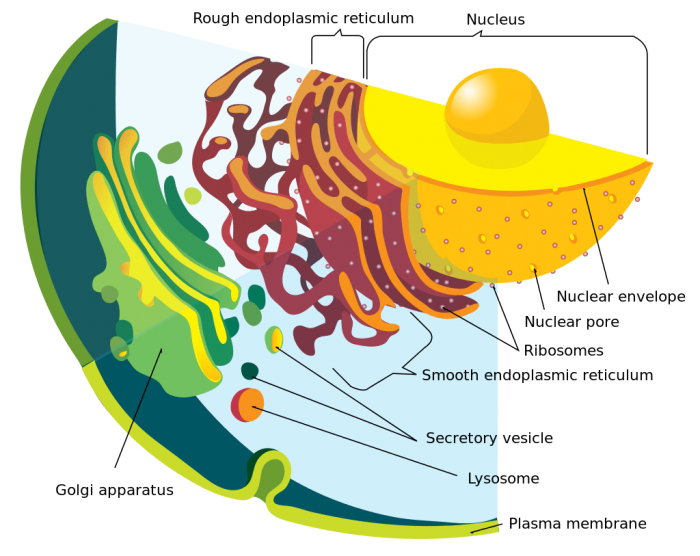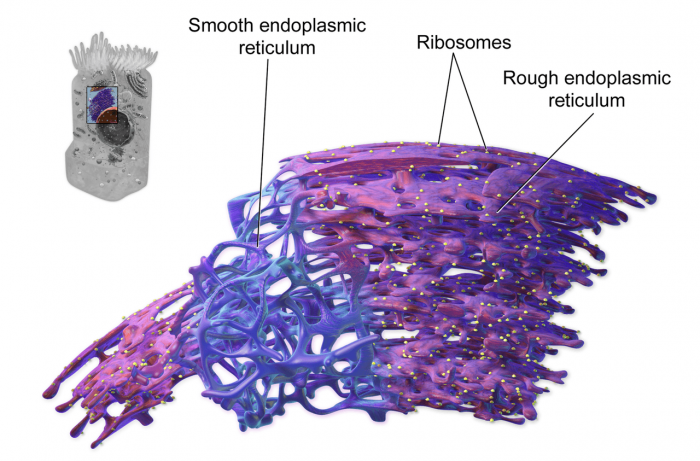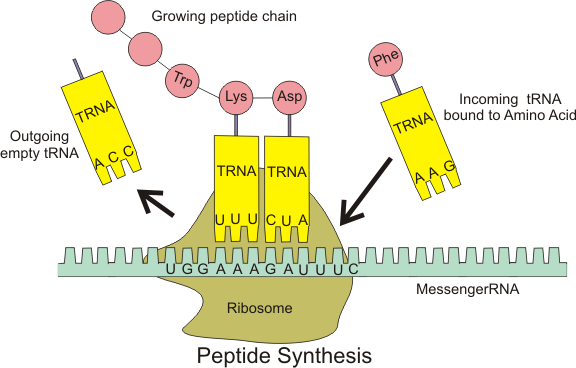
The endoplasmic reticulum (ER) is an organelle found within eukaryotic cells that is responsible for the transport, processing, and production of lipids and proteins. The endoplasmic reticulum produces both lipids and proteins for the membrane of the cell.
These lipids and proteins are also used to compose other parts of the cell such as vacuoles, the cell membrane, the Golgi apparatus, lysosomes, and secretory vesicles. There are two different portions of the ER – the rough ER and the smooth ER.

Photo: By Mariana Ruiz Villarreal LadyofHats – the diagram i made myself using adobe illustrator. as a source for the information i used the diagrams found here:[1], [2], [3], [4], [5], [6] and [7]., Public Domain, https://commons.wikimedia.org/w/index.php?curid=8152684
That’s a brief rundown of the endoplasmic reticulum, but let’s take a closer look at the ER to see what the roles of the two different sections are and how they interact with the other portions of the cell.
The Structure Of The Endoplasmic Reticulum
The endoplasmic reticulum is made out of long flattened sacks, linked together in a network of tubules. The endoplasmic reticulum is divided into two separate portions, the smooth endoplasmic reticulum,and the rough endoplasmic reticulum. The rough ER is referred to as “rough” because it has ribosomes attached to the outside of it, giving it a rough texture. The ribosomes are found on the cytoplasmic half of the membrane. The smooth endoplasmic reticulum lacks these ribosomes.
The endoplasmic reticulum’s inside is called the lumen. The endoplasmic reticulum runs a large portion of the cell, starting at the cell membrane and connecting it to the nuclear envelope. Because the endoplasmic reticulum is linked with the nuclear envelope, the ER’s lumen and the interior portion of the nuclear envelope can be thought of as one contiguous region. The rough ER is typically a number of flattened sacs linked together while the smooth ER is the tubular network.
The Rough Endoplasmic Reticulum

Photo: By BruceBlaus. When using this image in external sources it can be cited as:Blausen.com staff (2014). “Medical gallery of Blausen Medical 2014”. WikiJournal of Medicine 1 (2). DOI:10.15347/wjm/2014.010. ISSN 2002-4436. – Own work, CC BY 3.0, https://commons.wikimedia.org/w/index.php?curid=28223972
The rough endoplasmic reticulum is responsible for the manufacturing of secretory proteins and membranes. The synthesis of proteins in the rough endoplasmic reticulum is carried out by ribosomes, and the actual process of protein synthesis is referred to as translation. While the rough ER usually synthesizes proteins, in the case of white blood cells or leukocytes the rough endoplasmic reticulum synthesizes antibodies. Another exception to this rule is pancreatic cells where the rough ER creates insulin.
In most instances, the smooth endoplasmic reticulum and the rough ER are connected to one another, which enables the movement of membranes and proteins produced by the rough ER into the smooth ER. From the smooth ER, these proteins can be sent out to other organelles and areas of the cell. For example, the Golgi apparatus receives a variety of proteins from the smooth ER thanks to the transport of the proteins by transport vesicles. Once the proteins have been processed by the Golgi body, they will be sent off to their respective destinations so that they can be used for a variety of cellular functions, or exported from the cell through the process of exocytosis.
Within the lumen of the endoplasmic reticulum, a quality control process happens, where proteins are checked for any abnormalities. The Unfolded Protein Response is a stress response associated with the endoplasmic reticulum, and it responds to misfolded or unfolded proteins. The UPR’s purpose is to ensure normal functioning of the cell by preventing the release of malformed proteins, halting the translation of incorrect proteins, breaking down misfolded proteins, and starting the signaling pathways that increase the creation rate of molecular chaperones that help ensure proteins are properly folded. Various problems can occur when this quality control process incorrectly blocks improperly produced proteins, with conditions like cystic fibrosis rejecting the protein if there are even slight variations within it, causing the individual to miss out on the proteins entirely when they may otherwise just receive a slightly worse version of the protein.
The Smooth Endoplasmic Reticulum
The smooth endoplasmic reticulum has various functions such as the creation of lipids and carbohydrates. Cholesterol and lipids such as phospholipids are used to create the membrane of cells. In addition to the creation of lipids/carbs, the smooth endoplasmic reticulum functions as a holding area for vesicles that will end up transporting various proteins to other parts of the cell.
The smooth ER also creates enzymes that detoxify substances, within liver cells. Liver cells have a large amount of smooth ER in comparison to other cells since the function of the liver is to detoxify byproducts of the metabolism and to handle things like excess amount of ethanol caused by drinking alcohol. In muscles cells, the smooth ER plays a role in the contraction of the muscles, while it creates hormones in brain cells. The contraction of muscle cells is prompted by the release of calcium ions, and these ions originate within the smooth endoplasmic reticulum. The smooth ER is also involved in the creation of steroidal hormones within the endocrine glands and adrenal cortex.
Summarizing The Role Of The Endoplasmic Reticulum
To summarize, the Endoplasmic reticulum is an organelle which can be found in the cells of plants and eukaryotic animal. The endoplasmic reticulum is divided into two interconnected regions: the rough endoplasmic reticulum and the smooth endoplasmic reticulum. Both types of the ER are membrane-bound and are linked together by flattened tubes.
The rough ER is called “rough” because it is covered in millions of membrane-bound ribosomes. The ribosomes are involved with the quality control, folding and production of proteins. The Smooth ER is primarily involved with the manducation or lipids, steroids, and hormones. The Smooth ER also has a role in detoxification and metabolism as well. Proteins which are incorrectly folded or formed are rejected and sent to be broken down to amino acids, which can be reused to produce more proteins.
The Ribosomes

Photo: By Boumphreyfr – Own work, CC BY-SA 3.0, https://commons.wikimedia.org/w/index.php?curid=7200200
Since ribosomes play such an important role in the operation of the rough endoplasmic reticulum, let’s go over the operation and structure of the ribosomes as well.
Ribosomes are comprised out of two parts, a small subunit, and a larger subunit. The ribosomal subunits are created within the nucleolus, a smaller structure within the nucleus, and then they pass through the nuclear membrane to reach the cytoplasm. Once in the cytoplasm, these subunits will join together during the process of protein synthesis, becoming a complete ribosome.
In order for ribosomes in the cell to engineer proteins, the nucleus produces messenger RNA or mRNA. This mRNA is then dispatched from the nucleus into the cytoplasm where it integrates with the ribosomes. The two subunits of the ribosomes combined with the mRNA to begin the process of protein synthesis. Transfer RNA or tRNA is another type of nucleic acid found within cells and the tRNA is linked to the amino acids within the cell, and when the mRNA provides the needed instructions for synthesis the ribosomes pull off amino acids from the tRNA. The tRNA then bonds with another amino acid. By repeating this process, the ribosome constructs a long polypeptide chain that will become part of a protein.
Ribosomes help translate the protein-coding genes found in messenger RNA into their respective proteins. The function of ribosomes is to join together amino acids and create polypeptide chains, with these peptide chains eventually becoming fully functional proteins after more modification.
As mentioned above, ribosomes can be found linked to the rough endoplasmic reticulum, yet they can also be found floating freely within the cell’s cytoplasm. No matter where the ribosomes are found in the cell, they typically congregate in small clusters called polyribosomes or polysomes during the process of protein synthesis. These clusters let proteins be copied multiple times and lets them be synthesized at one time from just one mRNA molecule.
The free ribosomes typically create proteins that carry out their functions in the cytoplasm of the cell. In contrast, the bound ribosomes typically engineer proteins which will be exported from the cell out to other cells or fused with the cell membrane. Bound ribosomes and free ribosomes are interchangeable, and they can switch their functions according to the cell’s needs. Other organelles, like chloroplasts and mitochondria, possess their own ribosomes. These organelle specific ribosomes are smaller than independent ribosomes found throughout the cell, being around 30S to 50S in comparison to the size of the regular ribosomes – 40S to 60S.
Other Parts Of The Cell
The Endoplasmic Reticulum is just one of the many important parts of the cell. Other important cell parts include the following:
Cell Membrane – A semi-permeable membrane which isolates the cell from the outside environment and contains the cytoplasm.
Golgi Complex – The Golgi Complex is the “post office” of the cell, which stores, processes, and ships cellular products off to their respective destinations.
Lysosomes – Small organelles containing enzymes which break down cellular macromolecules
Mitochondria -These organelles produce energy for the cell through the process of cellular respiration.
Nucleus – The “brain” of the cell, it controls the reproduction and growth of the cell. It also holds genetic information.
Peroxisomes – These structures utilize oxygen to degrade fats and detoxify alcohol.









